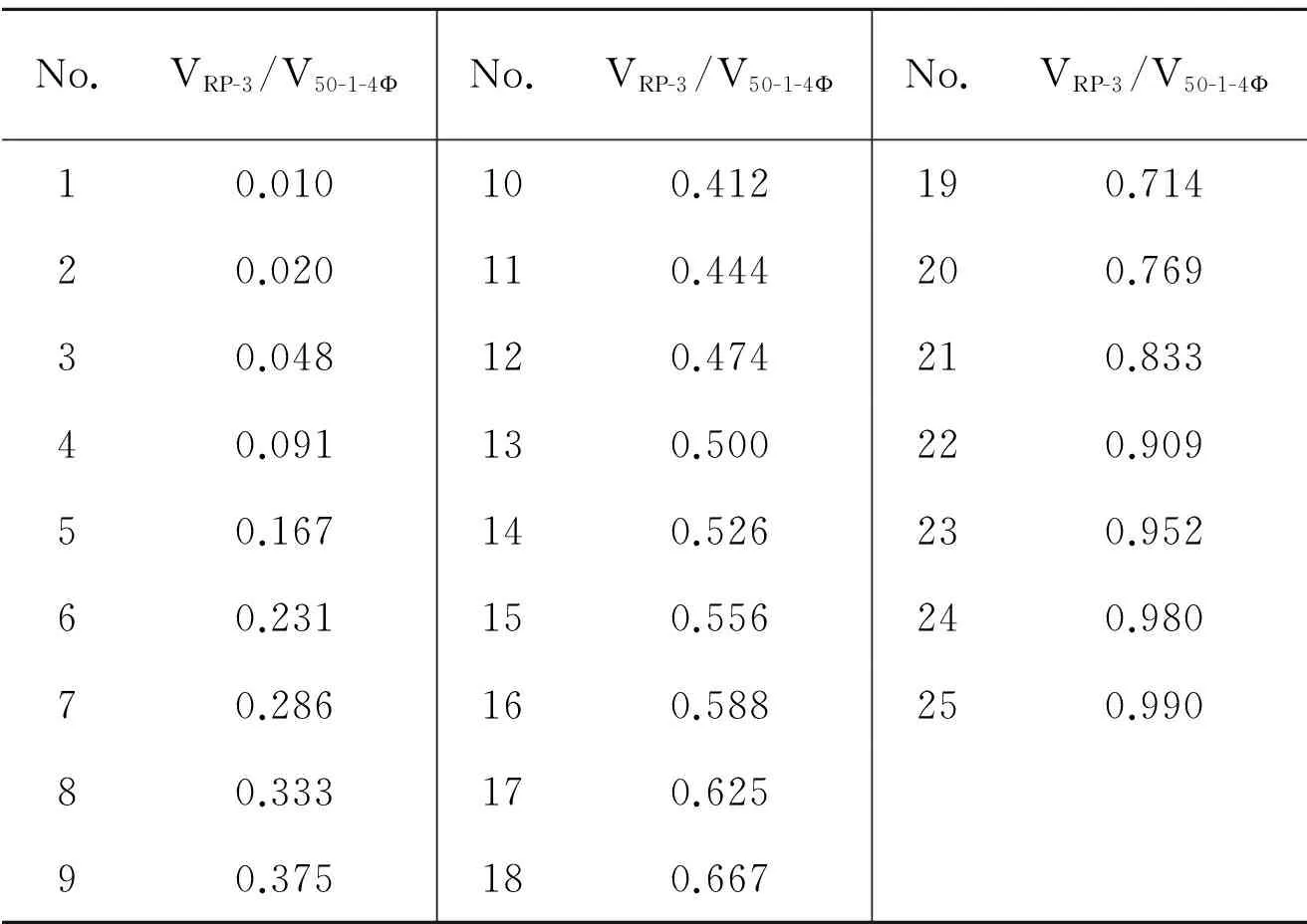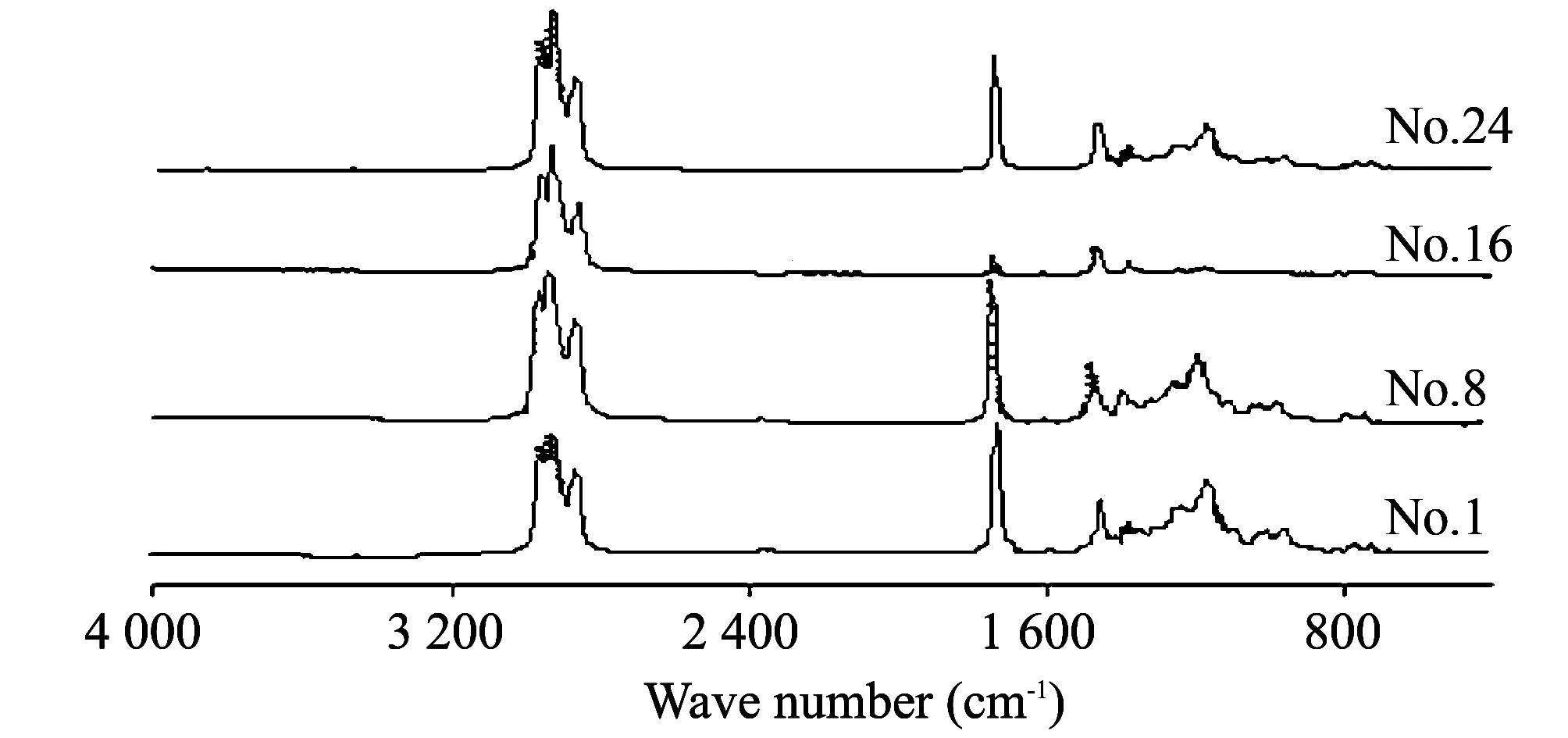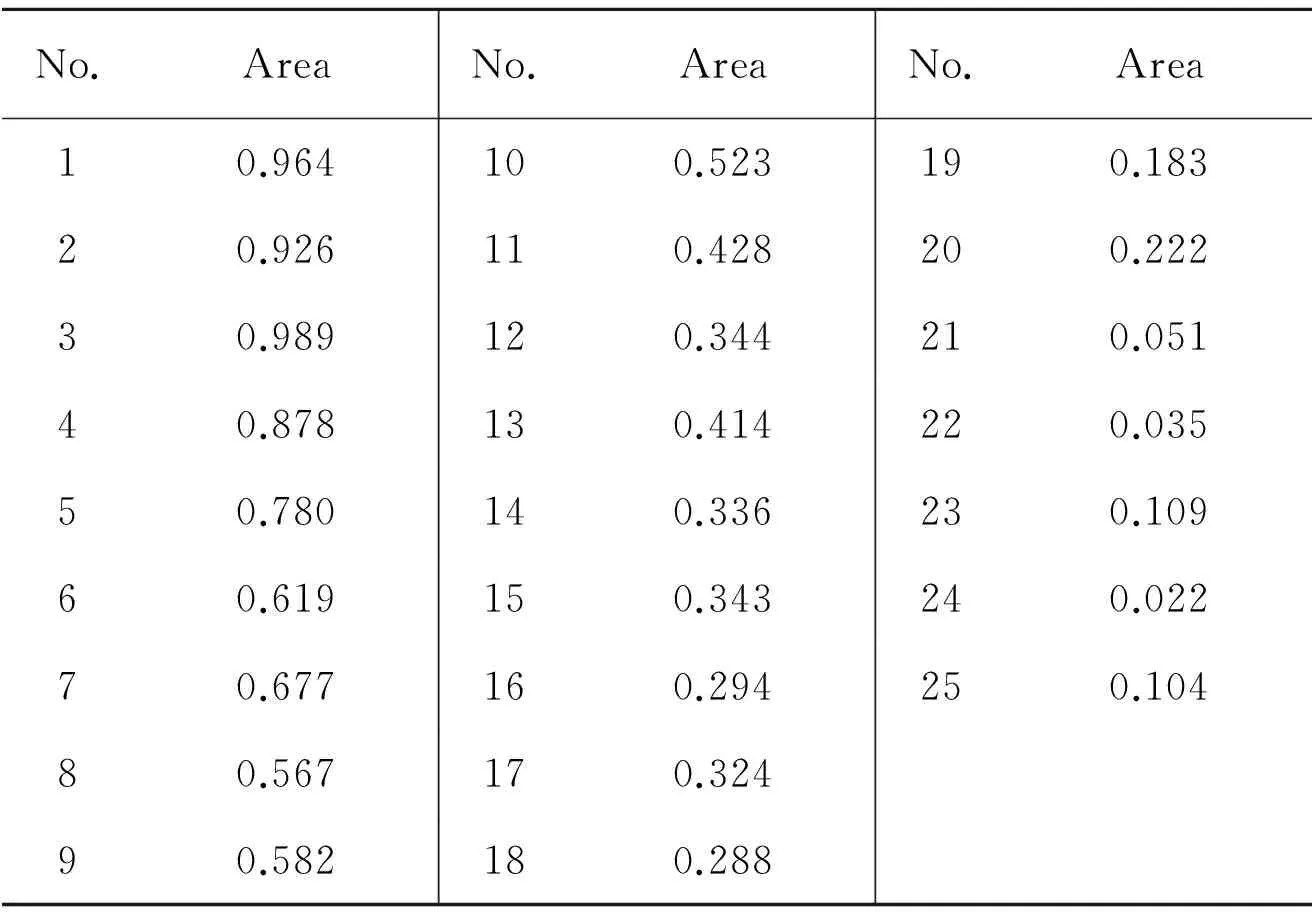Rapidly determining fuel pollution level of aviation lubricating oil 50-1-4Φ by mid-infrared spectrometry
2015-03-04ZONGYingJIANGXufengYUECongweiSUNJing
ZONG Ying, JIANG Xu-feng, YUE Cong-wei, SUN Jing
(Department of Material and Oil, Air Force Logistics College, Xuzhou 221000, China)
Rapidly determining fuel pollution level of aviation lubricating oil 50-1-4Φ by mid-infrared spectrometry
ZONG Ying, JIANG Xu-feng, YUE Cong-wei, SUN Jing
(DepartmentofMaterialandOil,AirForceLogisticsCollege,Xuzhou221000,China)
A series of aviation lubrication oil 50-1-4Φ samples were prepared with different RP-3 content, and then these samples were analyzed by Fourier transform mid-infrared spectrometer (FTIR). The infrared region of 805-755 cm-1was selected as quantitative area for determining fuel pollution level of aviation lubrication oil. Finally, correlation of the testing peak area and the fuel pollution level of corresponding samples were analyzed, and the regression equation was proposed. The results show that determining jet fuel pollution level of aviation lubricating oil by FTIR is feasible and reliable.
mid-infrared spectrum; aviation lubricating oil; fuel pollution level
Fuel oil may seep into the oil tank in the operation of aviation turbine engine due to various reasons, which will pose some serious safety hazards, e.g. the viscosity and flash point of aviation lubricating oil will decrease or the wear of machine element will increase or even to arouse explosion fire, etc.[1]. In recent years, great research achievements have been obtained in testing physical and chemical properties of oils and monitoring the used oil status by Fourier transform mid-infrared spectrometer (FTIR)[2-8]. However, there is no special method for determining the content of lightweight oil in the lubricating oil domestically and there are fewer reports on testing the pollution level of lubricating oil by using this method.
In this paper, 25 lubricating oil samples with different contents of RP-3 were analyzed by FTIR to provide more experimental data for rapidly determining fuel content in lubricating oil.
1 Experiment
1.1 Instruments
The main instruments used in this experiment include WQF310 FTIR produced by Beijing Ruili Inst-
rument Analysis Co., Ltd; HF-8 fixed liquid pool, with KBr windows with the optical distance of 0.1 mm, produced by Tianjin Tianguang Optical Instruments Co., Ltd.
1.2 Preparation of samples
The polluted lubricating oil samples were prepared with different proportion of RP-3 to 50-1-4Φ new oil. Micro-adjustable pipette was used to transfer different amount of RP-3 into 50-1-4Φ new oil. The volume ratios of RP-3 and 50-1-4Φ new oil in the prepared samples are shown in Table 1.
Table 1 Preparation table of aviation lubricating oil fuel pollution samples

No.VRP-3/V50-1-4ФNo.VRP-3/V50-1-4ФNo.VRP-3/V50-1-4Ф10.010100.412190.71420.020110.444200.76930.048120.474210.83340.091130.500220.90950.167140.526230.95260.231150.556240.98070.286160.588250.99080.333170.62590.375180.667
1.3 Experimental procedure
The above samples were analyzed by FTIR with the resolution ratio of 4.0 cm-1, scanning 32 times in total for every sample.
The correlation and regression of the data in Table 1 and infrared spectra of corresponding samples were analyzed, and then the regression equation was proposed.
2 Results and discussion
2.1 FTIR analysis
Referring to American Society for Testing and Materials (ASTM) standard Table A1.1, E2412-10, the testing peak area in the infrared spectrum ranging from 804.171 cm-1to 755.959 cm-1was used to calculate the fuel pollution level, i.e. volume ratio of RP-3 and 50-1-4Φ new oil. The FTIR spectra of the samples (No.1, 8, 16 and 24) are shown in Fig.1.

Fig.1 Infrared spectra of the samples No.1,8,16 and 24
The testing peak areas of all samples are shown in Table 2.
Table 2 Infrared spectrum peak areas of aviation lubricating oil fuel pollution samples

No.AreaNo.AreaNo.Area10.964100.523190.18320.926110.428200.22230.989120.344210.05140.878130.414220.03550.780140.336230.10960.619150.343240.02270.677160.294250.10480.567170.32490.582180.288
2.2 Correlation analysis of fuel pollution level and testing peak areas of all samples
Correlation coefficient between pollution level of all samples and their testing peak areas of the corresponding FTIR spectrum is 0.976 8, indicating significant correlation of fuel pollution level and the testing peak areas of all samples.
2.3 Regression analysis of fuel pollution level and testing peak areas of all samples
Polynomial regression curve for fuel pollution level of all samples and their testing peak areas in FTIR spectra is shown in Fig.2.

Fig.2 Polynomial regression curve of prepared samples
The curve equation is shown in Eq.(1). After calculating, fitting degree is 0.975 4, indicating that accuracy is 97.54% for the calculated fuel pollution level compared with the true value of samples.
Y=-6.771 8X6+39.637X5-74.175X4+

(1)
3 Conclusion
In this paper, 25 polluted 50-1-4Φ lubricating oil samples with different content of RP-3 were prepared. All samples were analyzed by FTIR technology. Referring to ASTM: E2412-10, the infrared region of 805-755 cm-1was selected as quantitative area for determining fuel pollution level of aviation lubrication oil. The correlation of the fuel pollution level and the testing peak area of corresponding samples was analyzed. The results show that they are highly correlated. Based on this, the regression analysis was made and regression equation was obtained. The fitting effect is good, showing that determining jet fuel pollution level of aviation lubricating oil by FTIR is feasible and reliable.
[1] ZONG Ying, JIANG Xu-feng, SUN Jing, et al. Rapidly determining kinematic viscosity of aviation lubricating oil 50-1-4Φ by mid-infrared spectrometry. Journal of Measurement Science and Instrumentation, 2014, 5(3): 79-82.
[2] LI Yong. The determination of kerosene oil content in lubricating oil. The Experimental Science and Technology, 2009, 7(3): 49-50.
[3] WEI Huan, ZHONG Shao-fang, HU Jiang-yong, et al. Fast determination of benzene in gasoline by mid-Infrared spectrometry. Chinese Journal of Spectroscopy Laboratory, 2008, 25(4): 621-624.
[4] WEI Huan, CHEN Yan, HU Jiang-yong, et al. Determination of aromatic and olefin in motor gasoline by mid-infrared spectroscopy. Chinese Journal of Spectroscopy Laboratory, 2011, 28(3): 1306-1310.
[5] WANG Yong, CHEN Hai, LIU Wen. Determination of diene value in cracking gasoline by infrared spectrophotometry. Modern Scientific Instruments, 2007, (6): 105-107.
[6] WANG Li-jun, CHENG Zhong-qian, QI Bang-feng. The determination of oxygenates in clean gasoline by mid-infrared spectroscope. Contemporary Chemical Industry, 2005, 34(5): 359-361.
[7] ZHAO Sheng-hong, HUANG Yi, LIU Duo-qiang. The application of mid-infrared spectroscopy in oil analysis. Petrochemical Industry Application, 2009, 28(7): 6-7.
[8] JIANG Yuan-xing. Lubricating oil monitoring technology and its application to marine machine. Lubrication Engineering, 2005, (4): 193-195.
中红外光谱法测定航空润滑油50-1-4Φ燃油污染水平
宗 营, 姜旭峰, 岳聪伟, 孙 静
(空军勤务学院 航空油料物资系, 江苏 徐州 221000)
本文对配制的不同3号喷气燃料含量的50-1-4Ф润滑油样品作为航空润滑油燃料污染水平测定的标准模拟油样进行红外光谱分析, 选择红外谱图中805-755 cm-1区域作为测定滑油燃料污染水平的定量区域, 对此区域峰面积与相应的样品燃料污染水平的相关性进行分析并给出回归方程。 结果表明, 利用傅立叶变换红外光谱法测定航空润滑油的喷气燃料污染水平是可行的, 测定结果是可靠的。
中红外光谱; 航空润滑油; 燃料污染水平
ZONG Ying, JIANG Xu-feng, YUE Cong-wei, et al. Rapidly determining fuel pollution level of aviation lubricating oil 50-1-4Φ by mid-infrared spectrometry. Journal of Measurement Science and Instrumentation, 2015, 6(2): 190-192.
10.3969/j.issn.1674-8042.2015.02.014
JIANG Xu-feng (jiangziya@163.com)
1674-8042(2015)02-0190-03 doi: 10.3969/j.issn.1674-8042.2015.02.014
Received date: 2015-03-08
CLD number: TP274+.5 Document code: A
猜你喜欢
杂志排行
Journal of Measurement Science and Instrumentation的其它文章
- Modeling and simulation of turbofan engine based on equilibrium manifold
- Prouhet-Thue-Morse sequence and atomic functions in applications of physics and techniques
- A fuzzy immune algorithm and its application in solvent tower soft sensor modeling
- Methane concentration detection system based on differential infrared absorption
- Use of online electrical conductivity meter to monitor cold decomposition of carnallite
- Modelling and simulation of high-speed milling chatter regeneration based on MATLAB
